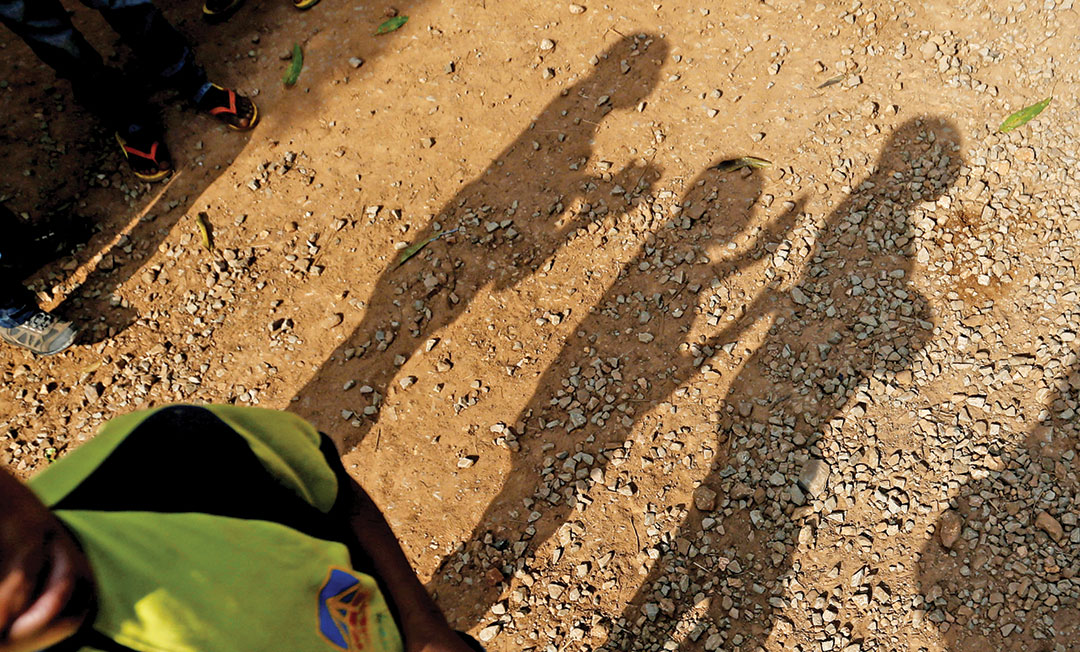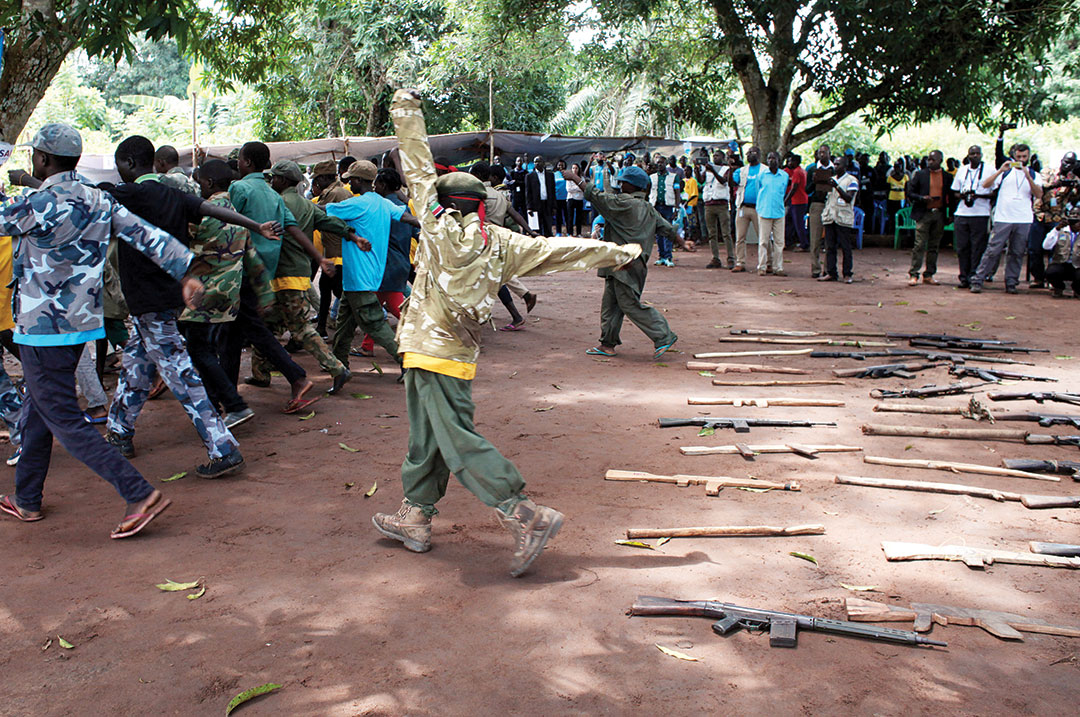ADF STAFF | Photos by Reuters
If any country should know about the disarmament, demobilization and reintegration of enemy fighters, it would be Uganda with its experience with the Lord’s Resistance Army.
Joseph Kony’s Lord’s Resistance Army, or LRA, is mostly inactive today, but during its violent years, dating to 1987, it wreaked havoc on Uganda. The group killed 100,000 people and displaced another 1.7 million. Kony and his fighters kidnapped tens of thousands of children, turning them into hardened fighters and rebel “wives.” His child combatants were taught to rape, torture and massacre.
Fighters who have escaped from the LRA and returned to their home villages face uncertain receptions. Many are welcomed with joyful open arms. Some face indifference, having been captured so long ago that no one remembers them. Others are treated as criminals and sent to prison.

Out of necessity, Uganda has been formulating ad hoc disarmament, demobilization and reintegration (DDR) programs for years. In many cases of returning LRA members, there is no DDR because the defections are never reported.
Journalist Anna Borzello’s report, “The challenge of DDR in Northern Uganda: The Lord’s Resistance Army,” notes that reception centers set up for defecting fighters in about 2007 suffered serious shortcomings, including failures to standardize counseling, go-home packages, lengths of stay and overall approach. Ex-combatants often were placed in refugee camps “where the situation is one of squalor and insecurity.”
“While the community in general welcomes home returnees, stigmatization is common,” Borzello wrote. “Giving packages or skills training to returnees can cause resentment among civilians.”
The ages of these returning fighters was, and remains, a problem. Many of these fighters were children when they were kidnapped, and many of them grew to be murderers. So are they treated as kidnap victims or ex-combatants?
“The emphasis on returnees as children and victims may distort the effectiveness of reintegration,” Borzello said. “While many returnees are profoundly disturbed by their experience, others have adapted to bush life and even grown to enjoy it.”
A study by the Stimson Center, a policy research group, focused on Uganda’s particular DDR challenges, noting that the initiatives taken “lack a coherent strategy.” The center pointed out three specific issues:
Local communities resented government-issued resettlement packages for defecting LRA fighters because they were perceived to be a reward for violence. The packages, part of Uganda’s 2000 Amnesty Act, presented a “visible display of resources” for the LRA defectors that the civilian and impoverished community members did not enjoy.

The local citizens also saw how international organizations had supported programs for the ex-fighters. The wider community got no such programs, “despite the fact that there might be a greater need among community youth overall.”
The ex-combatants resented the different levels of aid they were given. An abducted fighter who only spent weeks with the LRA before escaping might receive much more aid than an LRA member who had been abducted and fought for more than a decade.
STUDYING UGANDA
Government officials, the United Nations and nongovernmental organizations (NGOs) are studying the DDR programs in Uganda, Somalia and other parts of East Africa, looking for ways to improve DDR programs worldwide.
After studying the failures and successes of Uganda’s DDR program, United Nations University came up with a report in 2015 outlining the problems with any DDR plan. They include:
Where there is an ongoing conflict, the political buy-in necessary for voluntary DDR programs might be lacking, raising questions about whether DDR efforts will work in such environments.
Ongoing conflicts prevent the economic recovery required to absorb ex-combatants entering the labor force. This raises questions about how to design effective DDR programs that prevent relapse or criminalization when the conflict is finally over.
Little is known about the interplay between DDR and ongoing enemy military operations. Does the existence of continuing enemy military operations undermine DDR programs or encourage them?
The rising role of local, regional and international governments, along with NGOs and contractors, in DDR programs raises a variety of legal, operational and strategic challenges. What if the groups involved have inconsistent principles and human rights standards?
What are the legal and operational challenges in dealing with defecting fighters who are known to have been members of violent terrorist groups?
Borzello’s research raised other, similar questions. She noted that when a conflict finally ends, money will be needed to dismantle internally displaced people camps, resettle the population and rebuild the region. “The process will be expensive and require commitment from the Ugandan government and international donors,” she said. She noted that the police forces and courts would need to be strengthened so that justice can be served and the past laid to rest. The issue of war crimes must be resolved.
THREE TYPES OF COMBATANTS
Prosper Nzekani Zena, writing for the Africa Center for Strategic Studies, said that DDR candidates in postwar settings can be divided into three groups: armed actors who will voluntarily self-demobilize once a viable peace framework seems to be in place, combatants who continue to have vested interests in militancy, and fighters who are hesitant to disarm for fear of the consequences. Zena said it is the third group that offers the most potential for successful DDR.
“They are hesitant to disarm, fearing that they will be exposed and vulnerable amid an insecure, uncertain, and volatile environment,” Zena wrote. “They lack suitable income-earning alternatives, so may worry that disarmament would result in diminished well-being. However, they have little motive or interest in remaining a combatant. They are fence-sitters who need inducements and viable, gradual pathways to reject militancy.”
Zena found that the key ingredient for success is demonstrating to these combatants that they have a pathway to disarm and return to civilian life.
“By providing adequate opportunities to safely disarm, financial and psychological support to transition to civilian life, and sufficient training and opportunities to sustain themselves, DDR can draw such swing combatants away from militancy,” Zena wrote. “This also indirectly weakens remaining hardcore combatants by depleting the number of their supporters.”
Zena and other researchers have said that the first two components of DDR — demobilization and disarmament — are usually not the problem in reaching “fence-sitting” combatants. Demobilization can be politically sensitive, but those problems often are short-lived. Disarmaments mostly are a matter of organizing secure collection sites where arriving combatants don’t feel vulnerable. The third component, reintegration of ex-combatants into civilian life, is the most difficult.
Reintegration involves such tasks as job training, loans, job placement, helping former enemies integrate into peaceful settings, and helping them find permanent homes. Reintegration is the stage where so much can go wrong. Former fighters who disarm and face long delays in reintegration can become frustrated and bitter about the DDR process. Incomplete and ineffective reintegration poses the greatest risk for a return to armed violence.
“Reintegration is the most complex and critical yet least prioritized facet of DDR,” concluded Zena.

